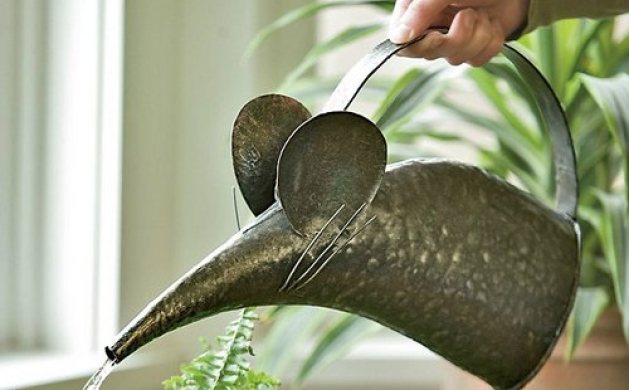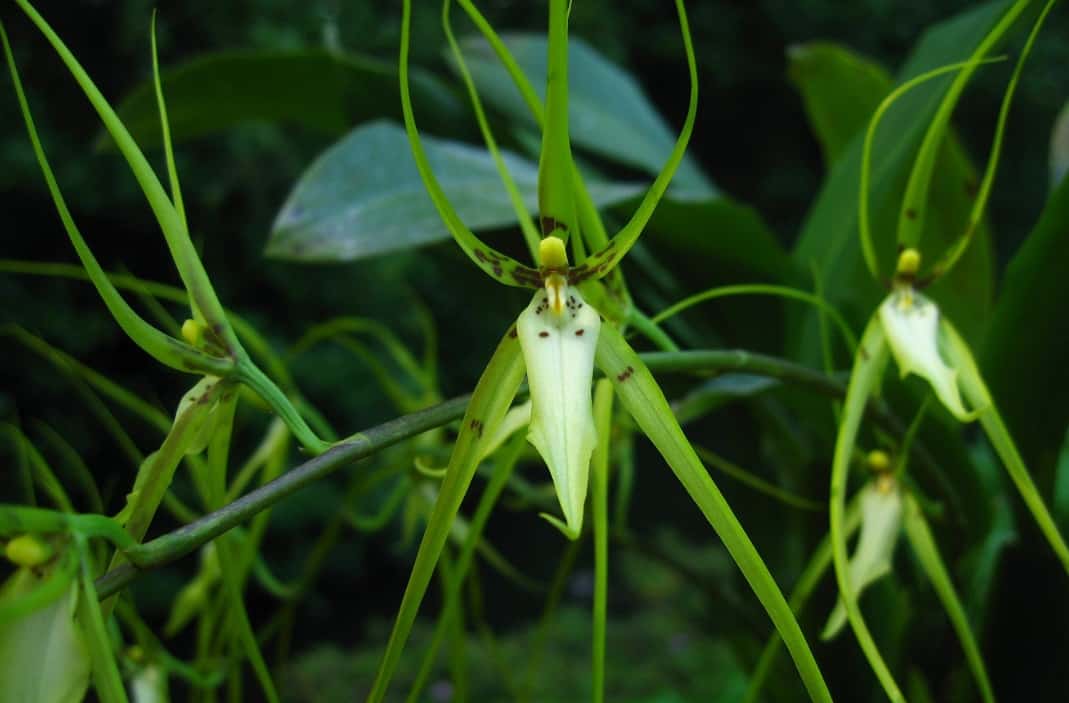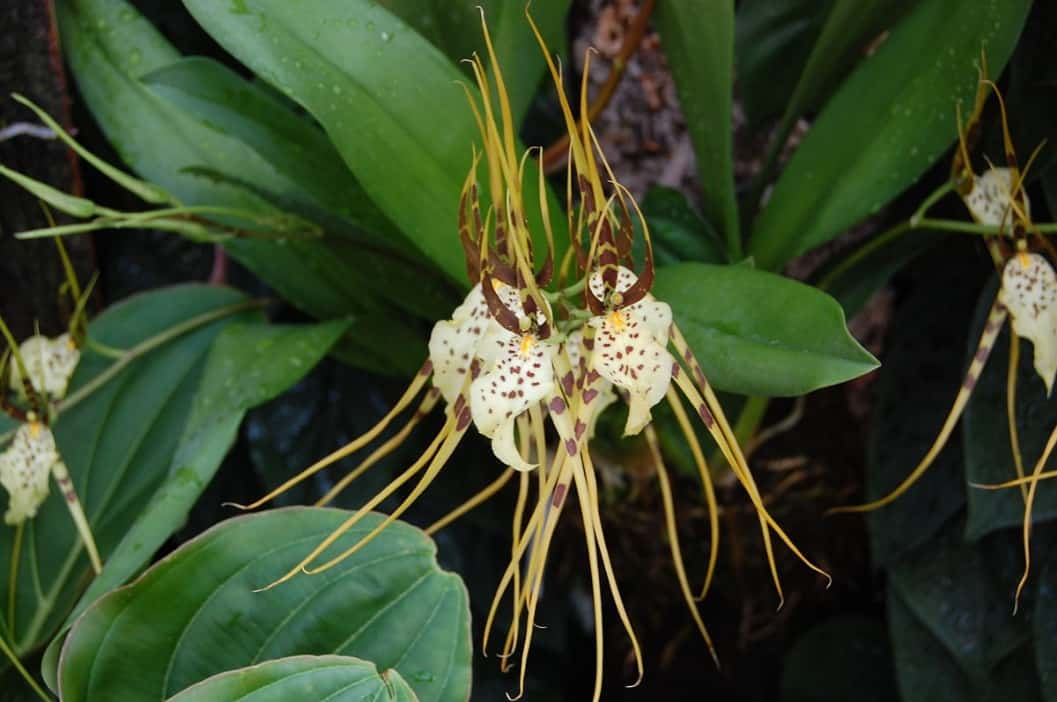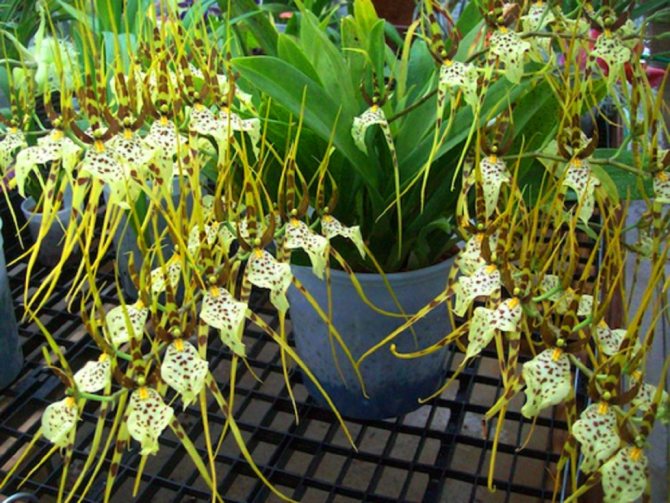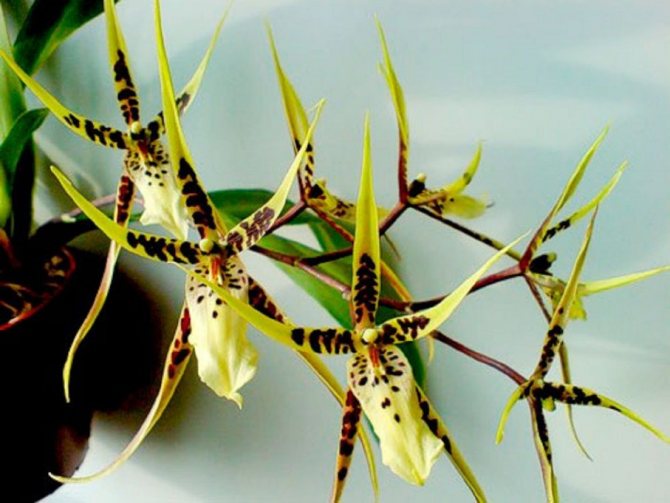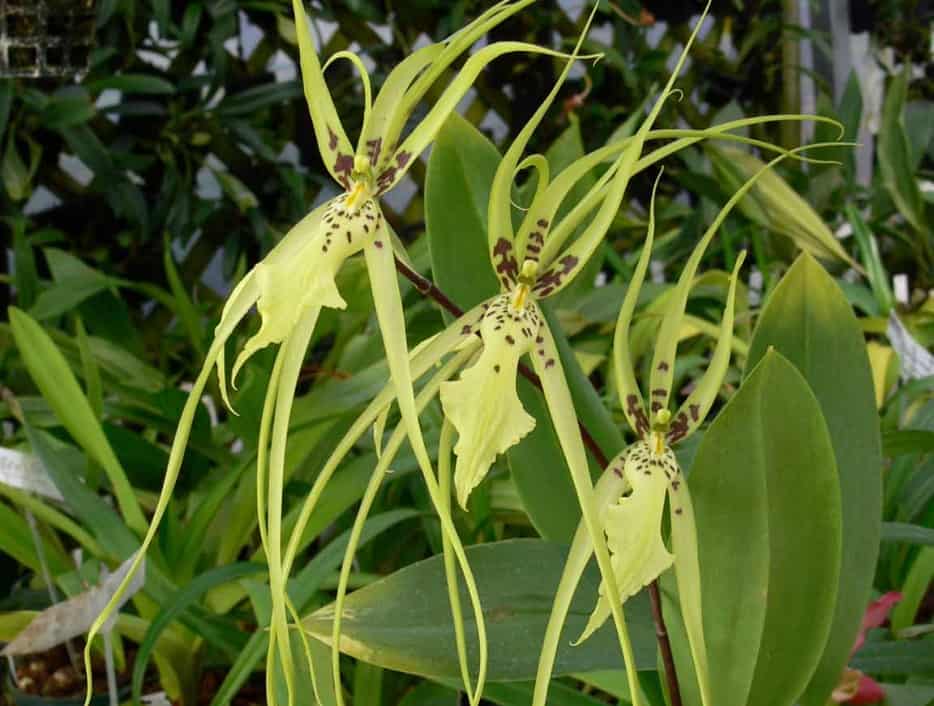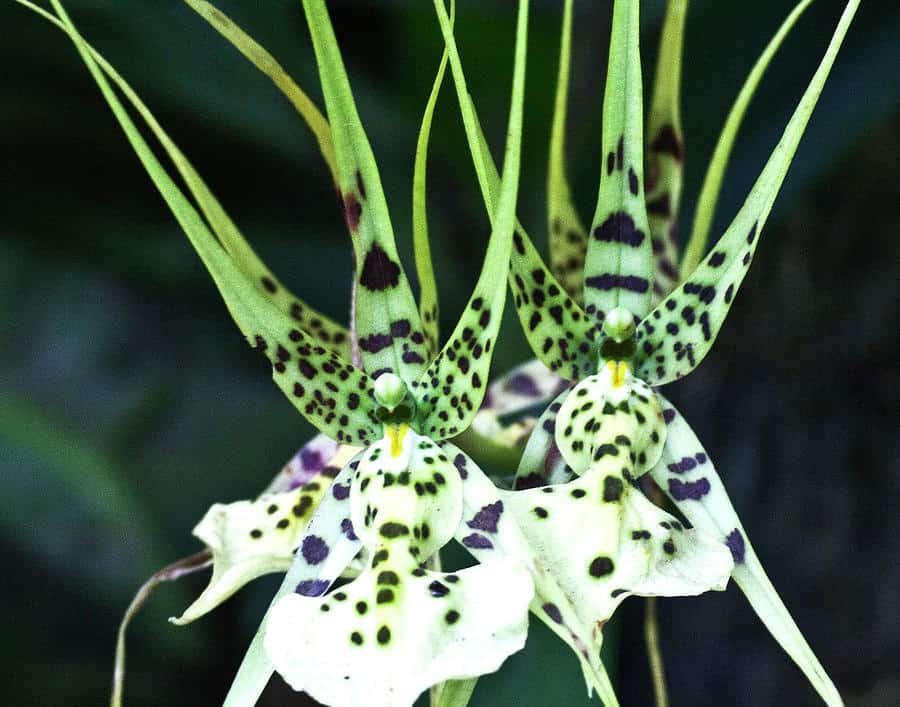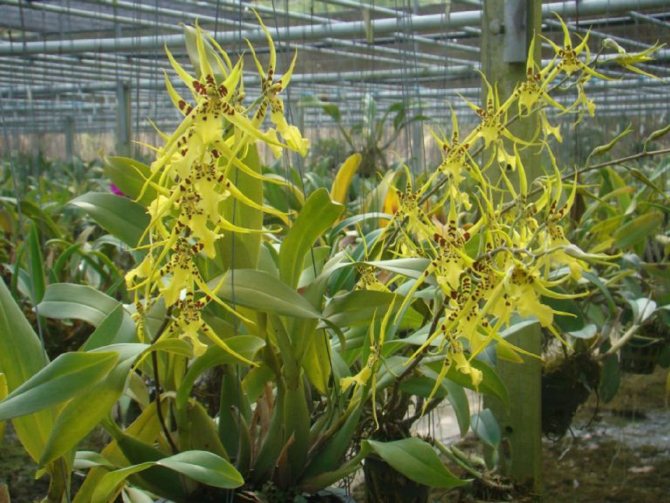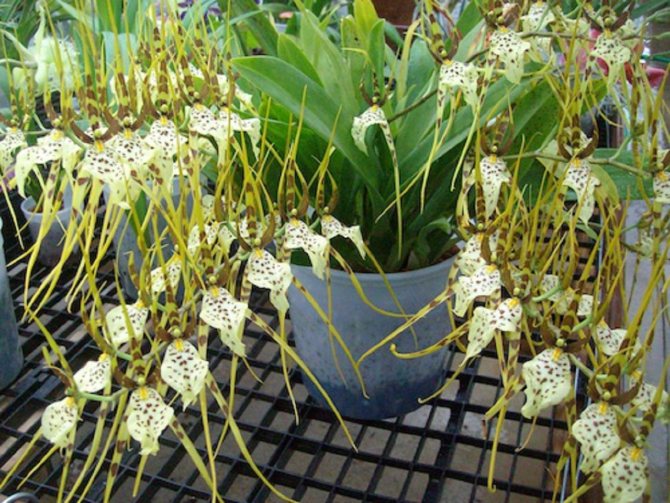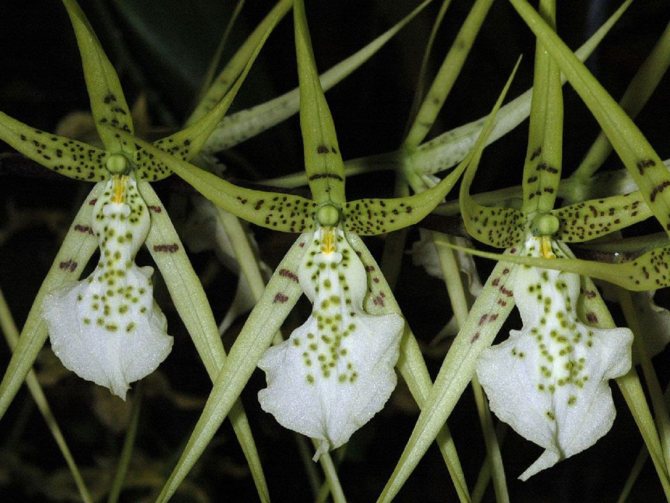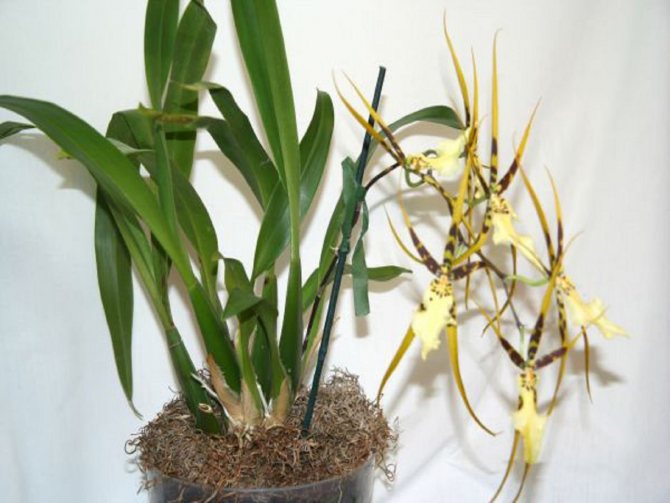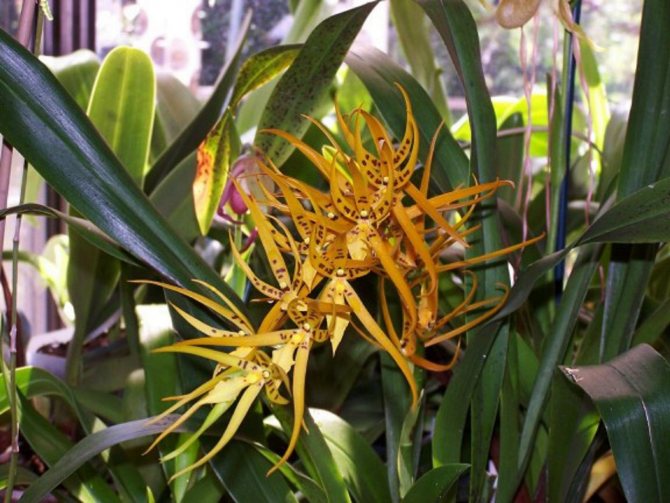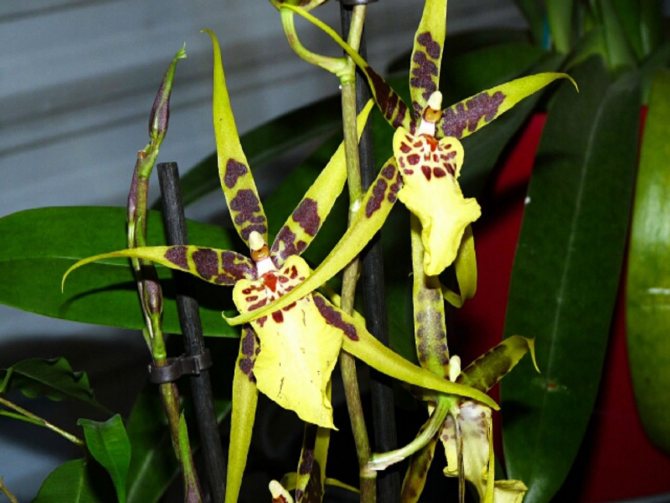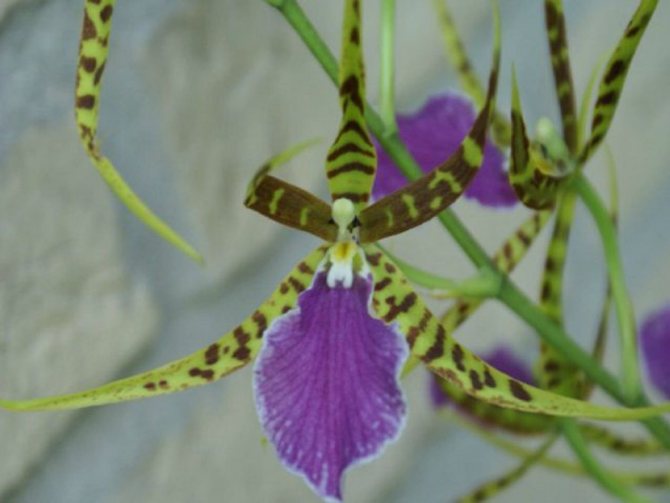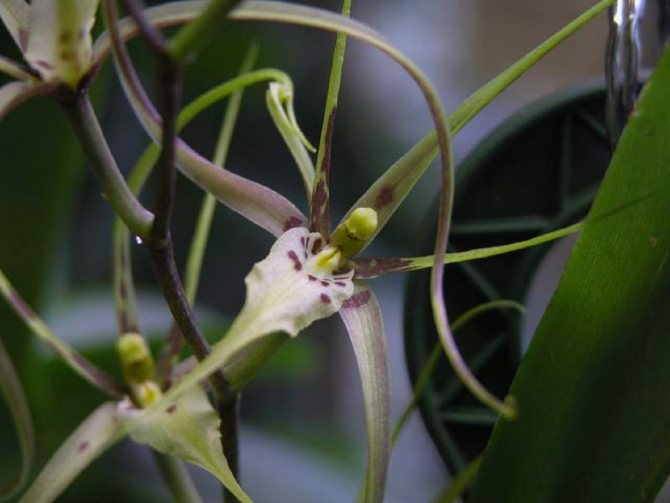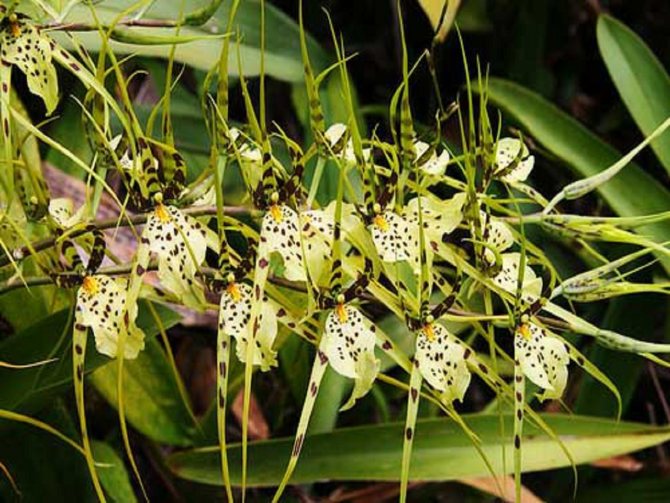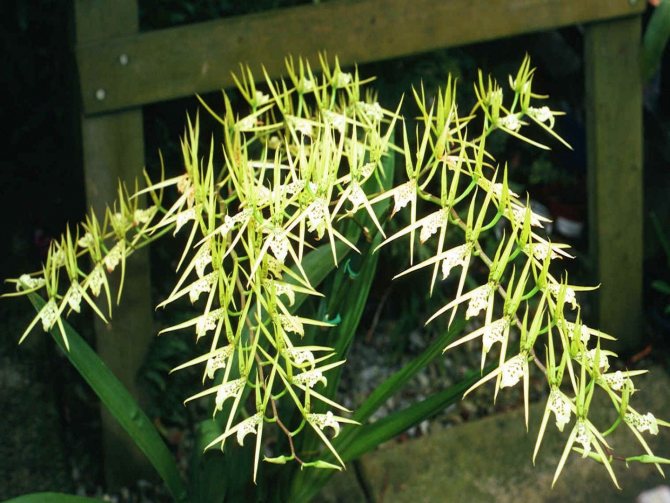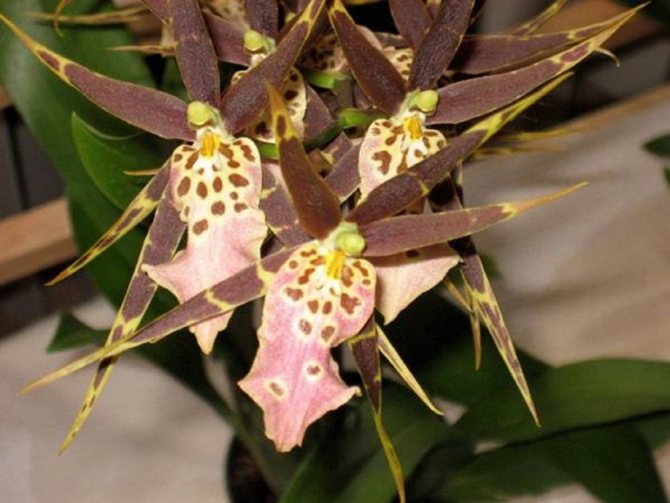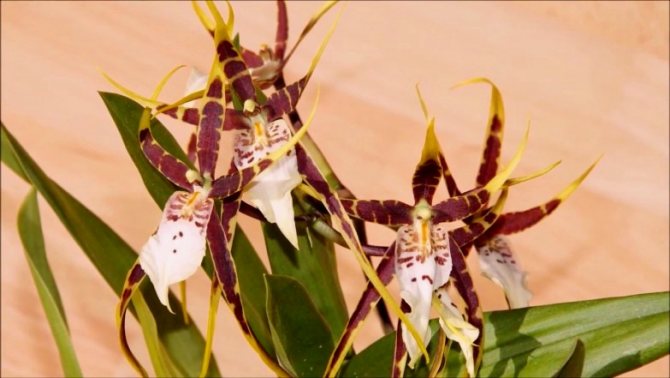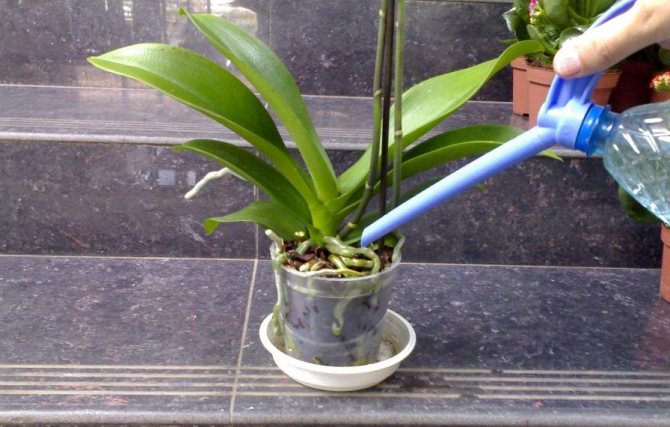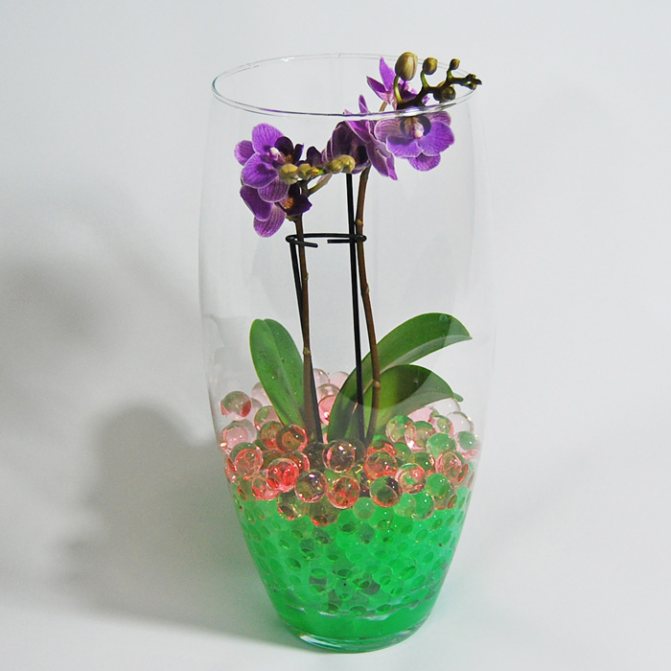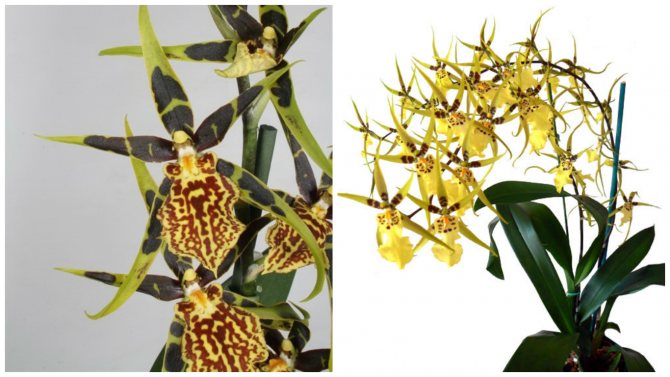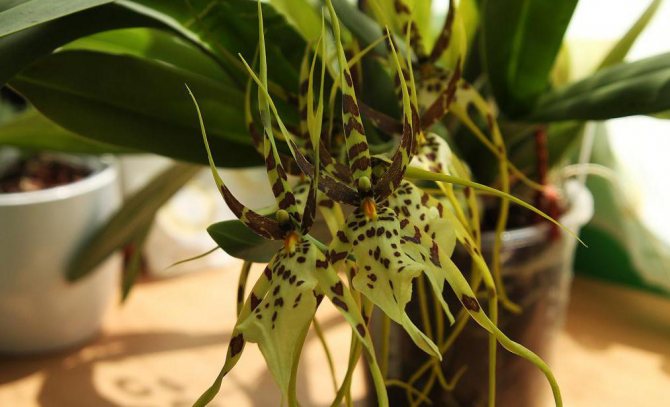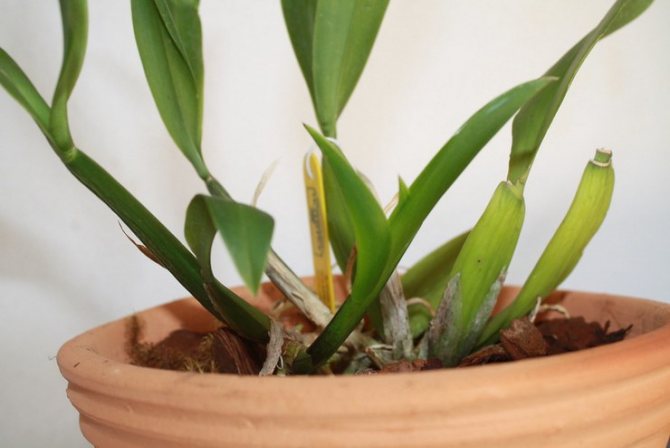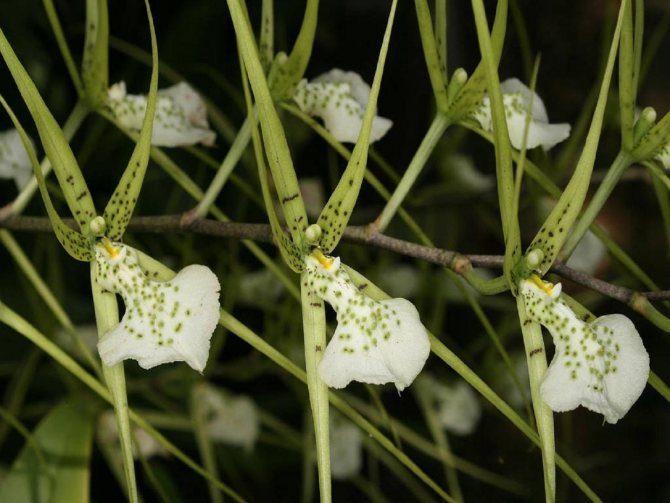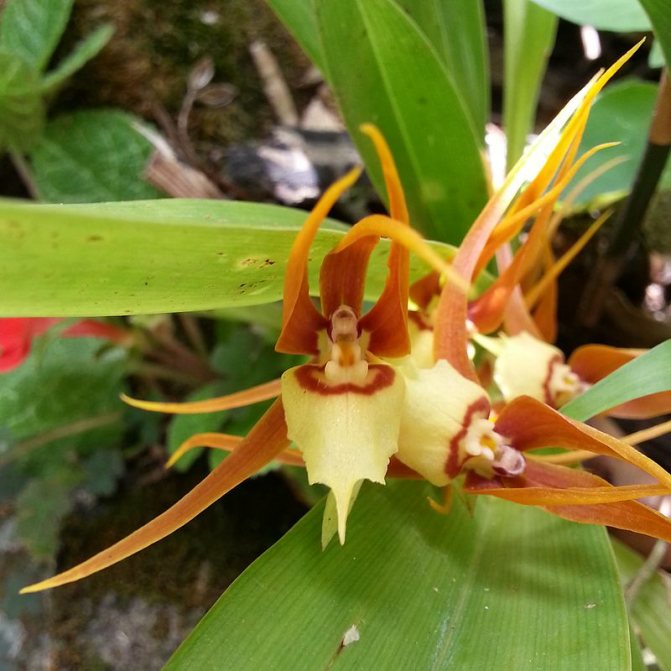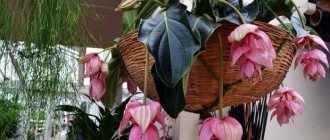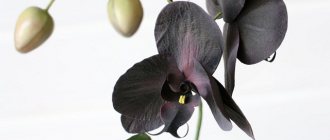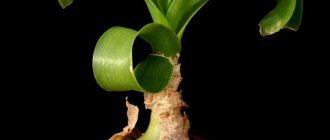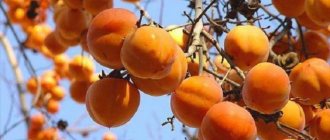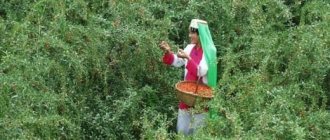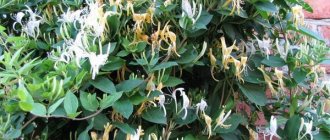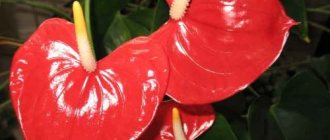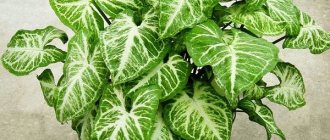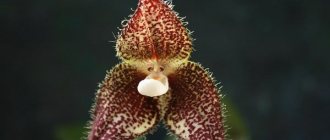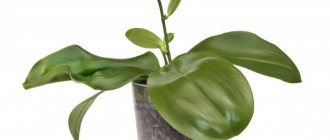The brassia orchid has long spread in our latitudes, although its homeland is the American tropics. Most often, the plant lives on heights up to 1.5 km. It thrives in a humid forest and releases flowers regularly. Small and very graceful buds resemble striped spider legs, for which the brassia is often called the "spider orchid".
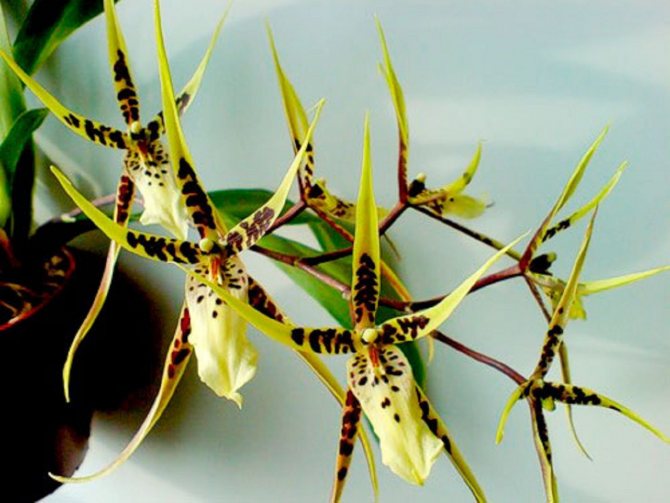
Here you will find out:
Appearance
Brassia inflorescences have a rather individual characteristic... The flower cups are elongated and have a sunny color with a greenish tint. In humans, this species is called "orchid - spider". Pseudobulbs are one or more linear-lanceolate leaves at the top.
Forking in Brassia is sympodial, which means that after the end of development, the pseudobulb dies, and a new one appears in its place. The flower has a creeping shoot, is slightly close to the soil, it is called a rhizome, and therefore is smaller than average in brassia, and pseudobulbs grow on it in a heap. The orchid throws up to 15 inflorescences. The transition shadow has a chocolate color with light green dots, and vice versa, a light green color with chocolate spots.
Prophylaxis
Effective ways of prevention:
- Maintain the interval between waterings, especially in winter. All layers must dry.
- Allow the water to drain completely after watering so that it does not stagnate in the pan.
- Ventilate the room regularly.
- When symptoms of disease or parasite attack appear, treat the plant with a fungicide.
- Apply fertilizer to wet roots - after watering or spraying.
- Before planting, pour boiling water over the soil or steam in a water bath for the purpose of disinfection.
Orchid Brassia is an unpretentious houseplant compared to other exotics. Delights the eye with beautiful colors with proper care almost all year round. The main thing is to maintain the optimal temperature and humidity level in the room.
If you find an error, please select a piece of text and press Ctrl + Enter.
Spider orchid varieties: their description and photos
Warty
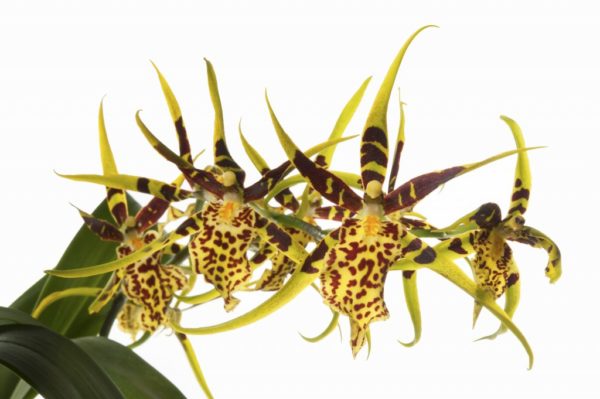

This is the species from which it is best to start growing these plants. Because the species is quite easy to care for. It starts flowering easily at home and sometimes lasts a whole year with the smallest interval. Each Brassia flower stays fresh for a month... The height of this species does not exceed half a meter, but the stem of the flower can grow up to 80 cm. The aroma of this species is individual, for an amateur.
We recommend watching a video about the features of warty Brassia:
Tailed
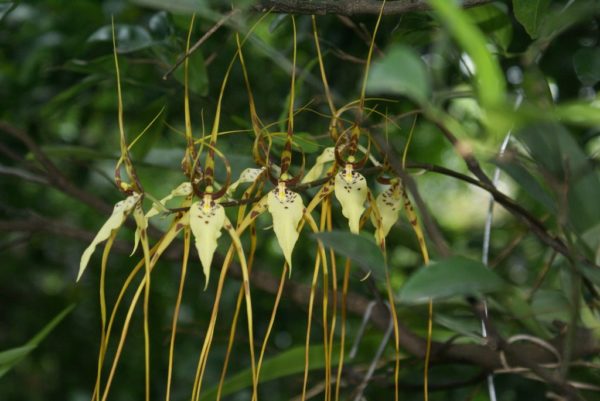

It has curved oblong flowers. The shade is yellowish with a pleasant scent. It is a hybrid of star-like flowers with dense blooms. Tailed brassia presents large inflorescences with a yellow tint and a fragrant vanilla scent.
Hybrids
Miltassia
Inflorescence of wax flowers of the most varied, mainly lilac shades. The petals are decorated with unusual patterns similar to the wings of a butterfly.
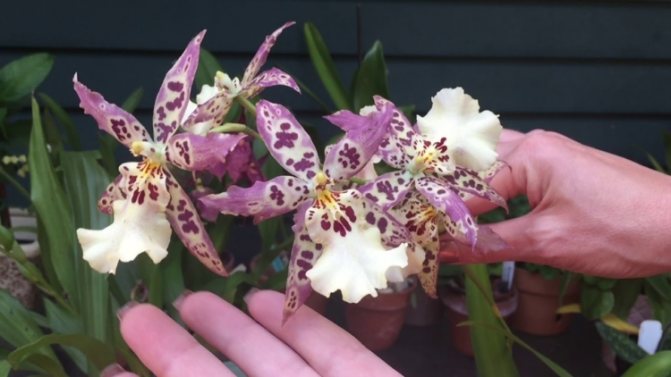

Bakerara
Elongated inflorescences, small bright yellow flowers covered with brown dots.
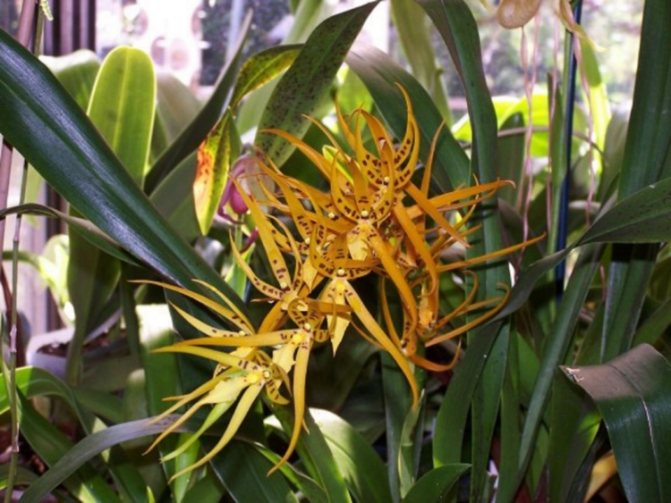

Brassidium
Bright hybrid, blooms thickly... The yellow petals are decorated with burgundy splashes.
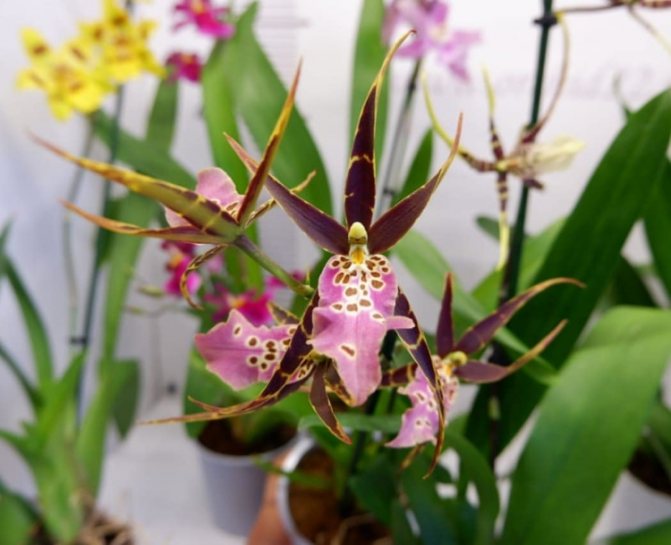

Rules for care and maintenance at home
Best of all, Brassia will be on the east window with a little shading.... It is also helpful to ventilate the brass area. In the summer, the daytime temperature is 22-23 ° C, the nighttime temperature is 17-19 ° C. In the winter, 16-22 C. The difference in daily temperature affects the formation of the bulb and flower thorn.
The plant also needs humidification of the air, otherwise the young shoots will shrink. Spraying and a humidifier will help. The pot can be placed in a pallet and wet expanded clay can be placed in it. The plant needs light for almost 10 hours a day. Therefore, it is worth taking care of the lighting.
Important: If there is little light, the Brassia orchid cannot bloom.
Coal, sphagnum and pieces of bark are suitable for the soil. The main thing here is to let the air pass. Good drainage is also needed. The pots can be made from plastic or basic opaque clay. It is best not to plant the plant in hanging baskets. Brassia has a weak rest period of about 2-3 weeks.
Plant care
The brassia orchid does not need careful care at home, it is classified as an unpretentious plant. The best place for brassia would be a window sill on the east or west side. The orchid is very fond of bright light, but the direct rays of the midday sun can burn it.
The optimum temperature for an orchid is between + 20 ° C and + 25 ° C, but cooling down to + 15 ° C is not critical either. A dweller of wet forests does not tolerate dry air. Regular spraying will help to save it from drying out. In winter, it is recommended to provide brassia with a rest period of 2-3 weeks. At this time, the temperature is reduced by 3-5 ° C and the frequency of watering is reduced.
Plants are watered by immersing the pot in a bowl of water for 15-30 minutes. After watering, you need to check that all excess liquid has been removed. Wrinkles on the bulbs serve as a signal of excessive watering. In this case, watering is stopped for a week.
In order for brassia to actively grow and even bloom in winter, additional lighting will be needed. The following techniques will help to make the brassia orchid bloom:
- provide long daylight hours (at least 12-13 hours);
- regularly apply fertilizers for orchids (a special complex of fertilizers with phosphorus, potassium and nitrogen is applied monthly);
- ensure a temperature drop from + 17 ° C at night to + 25 ° C during the day.
In May and September, it is recommended to place the pots on an unheated balcony. In such conditions, brassia will have everything you need for the proper development and formation of flower buds.
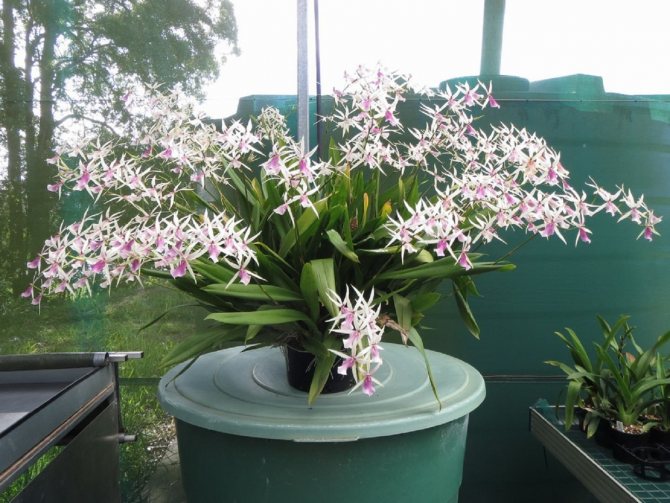

Step-by-step instruction
Planting a flower
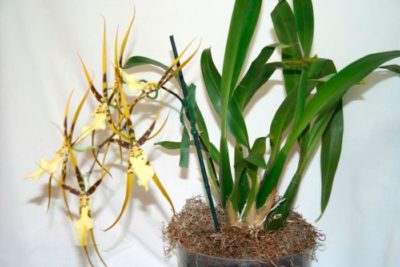

Brassia is a special flower, bulbs grow only on one side by a ladder, a new bulb grows on a "step" higher than the previous one.
therefore Brassia has its own landing rules:
- loose, spacious, high enough pot;
- during planting, the flower is slightly pressed against the edge of the pot;
- it is necessary to free up sufficient space for the growth of new bulbs;
- we plant deeper, taking into account the addition of the substrate to form a hill.
Watering the plant
Proper watering will allow our American guest to bloom. Water should be plentiful in summer, you can add irrigation. In winter and autumn, watering and irrigation are reduced, and a moderate dry regime should come into force here.
Water, necessarily settled or passing through a filter, is warm enough, slightly above room temperature. Watering Brassia should be done by immersion.... We dip the pot in a bucket of water for 15-20 minutes, then let the excess water drain into the pot, but let the water drain so as not to saturate the roots. The soil dries up between watering.
Advice: As soon as the flower stalks appear, watering stops for a few days, this will help to form new bulbs. If the bulbs have small wrinkles, watering stops for 5-7 days.
How to transplant?
Transplant your orchid usually in the spring, so it adapts better to new conditions.... If the substrate is very compacted, the bulbs have grown so much that they do not fit into the old pot, they have to hang over it - it's time for replanting. It is important not to bury the plant in the ground. Usually, the transplant is combined with the reproduction of the orchid.
When transplanting, follow the recommendations. It is safer to use the transshipment method:
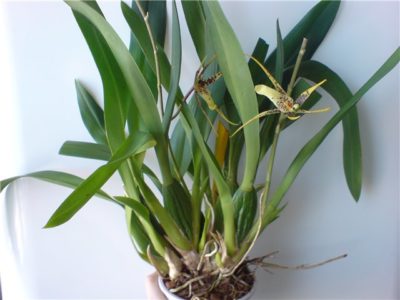

move the entire earthen vessel to another pot;- we clean the roots of the old soil with treated tools so that no infection gets in;
- pre-soak the root in warm water;
- remove diseased damaged roots;
- it is necessary to move the orchid from the center of the pot, leaving more space;
- the substrate is poured into 75% of the pot's capacity, taking into account its further pouring.
Transplant is stressful for Brassia... Its adaptation lasts 1-2 weeks, watch the flower!
Primer:
- good drainage for air circulation (pebbles, crushed stone, expanded polystyrene);
- charcoal;
- moss - sphagnum;
- moss (as an addition); pieces of pine bark of medium size.
The finished substrate can be disinfected with a water bath for 10 minutes... Pots can be made of plastic or enamel, the surface of the pot should be slightly roughened, the roots are easier to settle on such a surface. Florists advised keeping Brassia in hanging baskets or pots.
We recommend watching a video about the correct transplant of the Brassia orchid:
How to propagate?
A young orchid can be purchased at the store, but can be easily propagated at home. Brassia reproduces vegetatively, by division. The procedure is carried out in the spring, when it is actively developing.
- Adult orchids are cut next to the main uterine bulb.
- We cleanse the root of old, diseased processes. The cut points are processed with charcoal.
- Each renewed shrub should have 2 to 3 bulbs.
- Each part is planted in a prepared substrate.
- Water after 4-5 days by immersion in warm water.
- The first shoots are carefully cut off, the cut sites are treated with coal.
Transplantation and fertilization rules
For planting Brassia, a soil mixture for orchids is suitable, consisting of crushed pine bark, high peat and sphagnum.
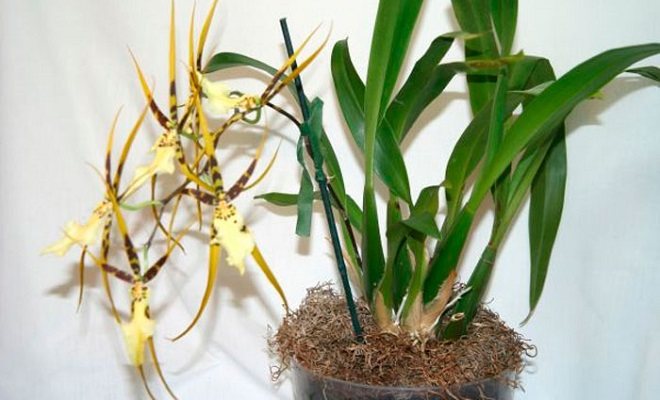

A flower transplant is carried out only if necessary, when there is too little space for the bulbs in the existing pot. During transplantation, be sure to pay attention to which side the new bulbs are formed on, and leave space on the corresponding side of the pot for new formations. If the bulbs grow in an upward direction, the flower must be planted as deep as possible.
The orchid should be fed once a month or together with watering, or by spraying the leaves of Brassia. For fertilization, you can use special formulations for Orchids, which can be purchased at a specialized store.
Diseases and pests
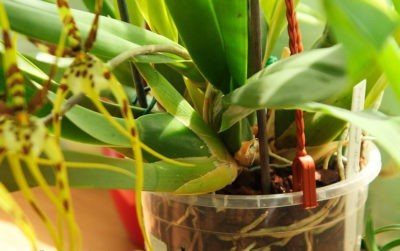

Spider mite is a dangerous pest for orchids. He drinks the sap of the plants. White dots appear on the leaves below, and then the leaves turn brown. A thin web covers the orchid. A hot shower spraying acaricides will help, the safest phytoverm. It takes 3 to 4 sessions with an interval of 5 to 6 days.- Scabbard and mealy worm infect leaf axils, especially in hot weather. Rescue orchid spraying with karbofos, fosalon and other chemicals. Processing is carried out in a week. Treatment is carried out within a month.
- Slugs - they are preserved by disinfecting the pot and pretreating the substrate. Root rot is a dangerous disease for Brassia. The reason is water and soil moisture. The orchid is especially susceptible to such diseases in winter. It fades, the leaves turn yellow. You can lose the flower. Helps to spray and water with foundation.For prophylaxis, repeat the procedure 3 times every 10 days. Reduce watering, adjust humidity and temperature.
If you are interested in other types and varieties of orchids, read our articles about the most popular of them: Multiflora, Dracula, Zigopetalum, Mini, Ludisia, Lady's shoe, Sogo, Oncidium, Tigrovaya and Liodoro.
Bloom
The orchid blooms along the stem, the process takes about a day. Fresh flowers spread a pleasant aroma throughout the apartment.
When and how?
Brassia blooms at the age of 3-4 years... It blooms all year round, except for winter, from 3 to 6 weeks.
How to follow her?
- When the first flower stalks appear, you need to stop watering for a few days. This is necessary so that new bulbs do not grow. During the flowering period, you need to water as usual. But it is desirable that the water does not fall on the flowers - this leads to a deterioration in decorative qualities.
- If a transplant is planned, it must be done before or after flowering. It is not recommended to touch the flowering plant.
- Nitrogen fertilizers are recommended before flowering. The orchid will bloom longer.
- From the beginning of May, it is recommended to take the orchid to the balcony or open veranda. This promotes earlier opening of the buds. The flower will receive enough sunlight and air naturally, without the use of additional devices. In autumn, direct sunlight will also not interfere with a flowering plant. This will help the orchid prepare for winter.
- The temperature is maintained as usual for Brassia. To stimulate the formation of new buds, you need to create a contrast between day and night temperatures. The difference should not exceed 4-5 degrees, otherwise the plant will start to hurt.
What if it doesn't bloom?


- Often the long-awaited flowering does not come due to lack of light... At the same time, the foliage is actively growing. In this case, you need to rearrange the pot in a lighter room, or take care of artificial lighting.
- Sometimes the orchid does not bloom due to excess nitrogen... Here you need to wait until the plant processes the fertilizer, and at the same time feed it with preparations containing a pass.
When the first ovaries appear, you need to stop watering for a week.
Testimonials
Inna. “I got the Brassia Orchid from a friend. The plant looked deplorable: it was planted in a decorative pots without holes in the bottom, the leaves turned yellow and limp. Water was constantly at the roots. Most of the roots were dark and soft, most of the plant had to be thrown away. Only two bulbs survived, which had hard, white roots. I dried them and planted them in new soil and a pot with a drainage hole. I will continue to look after and grow the orchid. I want to say that this approach to watering is a fast way to the death of a flower. "
Marina. “I got this unusual beauty already blooming. Graceful, slender petals with a pleasant aroma stayed on the peduncle for about two months. After flowering, I gave her a rest, reduced watering and did not fertilize. A month later, I noticed the appearance of new shoots. From that moment on, I began to feed the orchid with complex fertilizer and remove the pot for the night on the balcony with a temperature of 16-18 ° C. As many as three peduncles were formed from new shoots. I am pleasantly surprised. "
Svetlana. “I am sharing my experience of how I learned to determine the need for watering. It happened with my Brassia that the bulbs wrinkled between waterings, since I could not understand how often she needed hydration. I bought a blooming orchid with a bamboo stick to fix the peduncle. This stick is now serving me as a determinant of the moisture content of the substrate. I take it out and look: if it is half dry, then I need to water the plant. I water by immersing the flower in a container of warm water, leave it for 20 minutes. Then I take out the plant and wait for the excess water to drain through the bottom. "
Reproduction
New plant specimens are obtained by division:
- during transplantation, a part of the root system with aerial shoots (two to three pear-shaped pseudobulbs) is separated from the mother bush.
- cut sites are treated with an antiseptic (activated carbon is suitable).
- the separated pieces are planted in the prepared soil, covered with a glass or plastic cap;
- new specimens are watered with rooting-stimulating mixtures.
After the plant is accepted, another Brassia orchid will appear in the house. Caring for young flowers involves regular growth-stimulating top dressing and timely watering.
Description of the flower
In cultivated form, the Brassia variety is used for decorating residential premises.
External data:
- the plant is compact, grows up to 90 cm, the type of growth is sympodial (vertical);
- builds up flattened or ovoid green pseudobulbs (7x8 cm);
- the minimum length of the peduncle is 40 cm;
- on each flower arrow, from 10 to 16 fragrant inflorescences are formed, which bloom in late spring or early summer;
- large flowers - 12-15x10-12 cm, some specimens reach 25x12 cm;
- petals are narrow, elongated, light green, covered with green spots at the base;
- lip of a light green or white shade, contains small dark green blotches;
- on each pseudobulb, two emerald, belt-like leaves 38x5 cm in size are formed;
The buds bloom at the same time in a day, are located along the stem, thinning the pleasant aroma.
Duration of flowering is 2-3 weeks.
Humidity
Like most tropical plants, the brassia orchid loves high humidity. It is desirable to maintain this figure within 60%. To do this, install a special humidifier near the pot. If this is not possible, then a pallet with wet moss or pebbles will help. Place a pot on it so that no water reaches the drain holes.
In addition, do not forget to spray the foliage of your pet with warm, settled water every day. In the summer, it is advisable to hold this event several times a day. Give the flower a warm shower once a week. In winter, be sure to cover the batteries with damp towels.
Remember: dry air makes young leaves shrink quickly. And they are covered with a drying film, which then prevents them from straightening. To prevent this situation, keep the room humid, comfortable for the orchid.
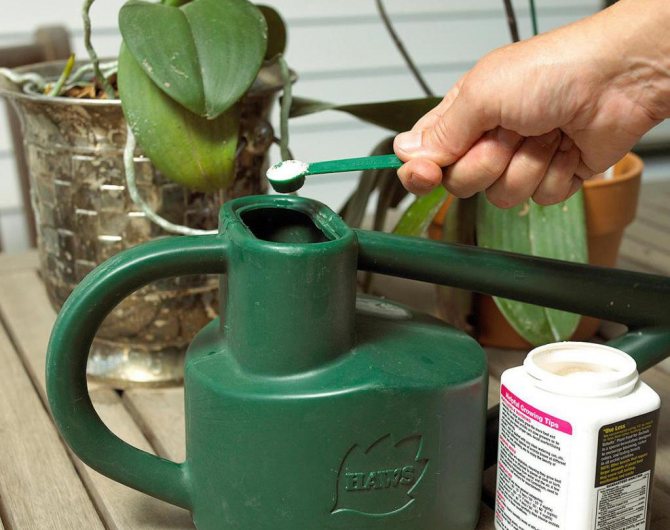

Most common colors
Brassia flower color:
- petals and sepals are bright orange with burgundy specks; lip - light yellow;
- delicate lime sepals and petals, almost completely covered with brown specks; lip — white, with green spots;
- bright yellow petals with small purple-brown spots; sepals - monochromatic, yellow; lip - light yellow;
REFERENCE! Orchid Brassia has a sympodial type of growth or branching. With it, several growing shoots are formed, connected by a rhizome. These lateral shoots develop and develop into a pseudobulb.
Old, adult bulbs die off. New shoots grow in two ways:
- horizontally - form a rhizome or rhizome;
- vertically - sprouts turn into bulbs, rise on a pot and resemble a ladder.
Temperature regime
Brassia is not particularly whimsical and quickly adapts to room conditions. She tolerates cold and summer heat normally. If the temperature in the room drops below + 150C, then, despite this, the plant will continue to develop further. In summer, it is better to keep it outdoors so that the recommended temperature difference occurs naturally (up to 6 degrees). The following temperature range is considered ideal living conditions - from + 230C to + 250C.
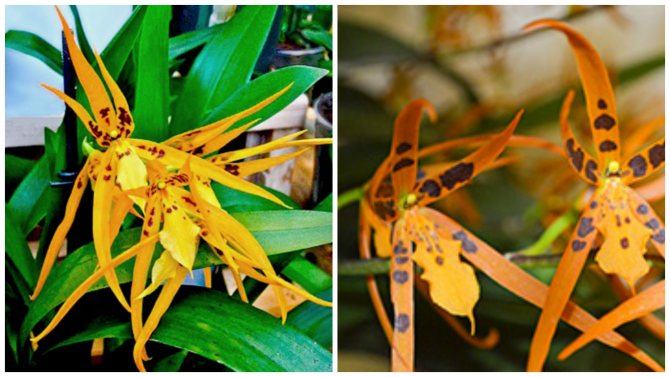

Growing
The process includes many stages.For the plant to grow and develop correctly, it is provided with all the necessary conditions.
Landing
The culture is propagated by seeds and dividing the bush. To do this, take a small transparent plastic pot. Holes are made in the bottom to leave excess moisture. Pieces of foam are placed on the bottom. Above - a layer of bark in fractions of 2.5-3 cm. It is harvested in advance, cut. Pebbles and wood are also taken as drainage.
The substrate is used commercially, especially for orchids. It is also prepared with one's own hand. To do this, take:
- 40% pine bark;
- 25% sphagnum moss;
- 25% charcoal;
- 10% dry leaves.
Seeds
Seeds are prepared before planting: first, they are disinfected. For this purpose, prepare a solution of 15 g of lime per 100 ml of water. It is filtered, after which the grains are placed inside for 10 minutes. The liquid is stirred periodically.
At home, Knudson's medium is used for germinating seeds, which is prepared according to the instructions. Its acidity should ideally be 4.8-5.2 pH. The solution is poured into sterilized vessels to a level of 1.5-2 cm, closed with a stopper and sterilized again. A pressure cooker is great for this. It is also used for sowing seeds: then spores and bacteria do not enter the container.
A vessel is placed in boiling water. The seeds are transferred using a sterile tube. For uniform distribution of the seed, the solution is shaken. The container is closed. All actions are performed quickly.
The jars are placed in an environment with a temperature of 18-22 ° C. Crops are provided with diffused light for 12 hours. Over time, leaves appear on the surface of the liquid, then roots grow. After a year, the sprouts are planted in a prepared steamed substrate. To do this, they are carefully removed from the jar, washed under running water.
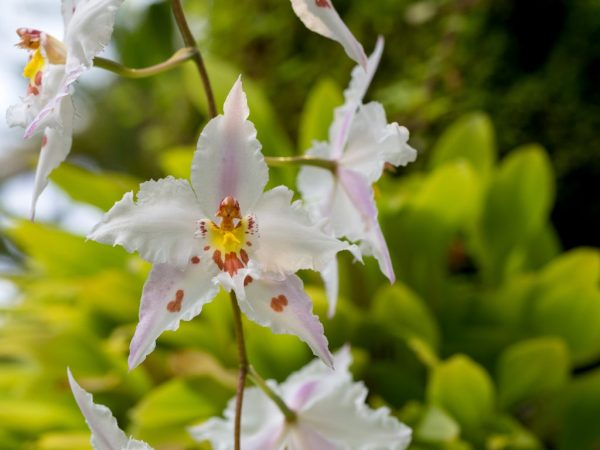

The cultivation process is long
By dividing the bush
Less time consuming process. For planting in spring, the plant is divided into parts. Each of them should contain 2-3 bulbs with healthy white roots. Spoiled and soft ones are removed. The rest are immersed in warm water so that they straighten and cleanse. They are planted in a substrate, placed on a windowsill on the east side. During the week, only spraying is performed, but make sure that water does not get into the center of the outlet.
Care
When growing Brassia at home, it is provided with good illumination for 12-13 hours a day. In winter, the plants are illuminated. Direct sunlight should not fall on the flower. The optimum temperature for proper development should be at the level of 20-25 ° C during the day and 17-18 ° C at night. The culture does not accept dry air, so it is regularly sprayed. Also does not tolerate drafts.
Watering is done in this way: a pot for 15-30 minutes. immersed in a container with warm, settled water. During this period, the plant will be saturated with moisture. Wrinkles on the bulbs indicate excessive moisture. In this case, watering is stopped for 7 days.
In winter, a dormant period begins for the orchid. To do this, it is placed in an environment with a temperature of 3-5 ° C for 2-3 weeks. The frequency of watering at this time is reduced. Also in May and September, the pot is placed on an unheated balcony.
Culture care includes a transplant, which is performed every 2 years. It is not worth performing the procedure once again. To extract the plants, press or knock on the pot. Then they pay attention to the roots:
- separate them from the old soil by hand, wash;
- dry and damaged parts are cut off with sterile scissors or a knife, capturing the healthy part;
- the places of the cuts are treated with sulfur or charcoal;
- allow to dry for several hours.
The pot is taken 4 cm larger in diameter compared to the previous one. It is washed with soapy water and boiled. The plant is planted in the center, without deepening too much, otherwise the sprouts will rot. The transplanted Brassia is placed under a warm shower (36 ° C). The next watering is done in 2-3 days.After transplanting, the plants are shaded, they are provided with high air humidity. For this purpose, you can place the pot near the aquarium.
Top dressing is done approximately every 10 days with a special fertilizer for orchids. They are used according to the following principle:
- from spring to summer, substances containing more nitrogen are introduced;
- from mid-summer to autumn - with a high content of potassium and phosphorus.
This ensures constant flowering and good vegetative development of the orchid. In winter, feeding is stopped.
Planting brassia: choosing a pot and substrate
Transplanting brassia has a negative effect on the general condition of the plant, therefore, it is better not to disturb the orchid unnecessarily. The signal for transplantation is tuberidia crawling out of the flower container or an overly compacted substrate.
The most suitable time for planting orchids is spring, when young shoots have already appeared and have formed their own root system at least 5–8 cm long, but all work must be done before budding begins. During transplantation, they are engaged in both the propagation of the bush, and the sanitary examination of the roots, followed by cutting off the damaged, dead and rotten areas.
A plastic or ceramic container is suitable; it is not necessary to plant a plant in a transparent pot. The substrate for growing brassia is compiled taking into account the requirements of good air permeability and looseness, the orchid develops poorly in a compacted soil mixture, the roots suffer from a lack of oxygen and gradually die off.
Pine bark, sphagnum moss, peat and some pieces of charcoal are suitable as components for the substrate; a layer of expanded clay drainage is required at the bottom. Considering that the orchid grows pseudobulbs in one direction, it is advisable to place it in the pot not in the center, but away from the wall to which the tuberidia growth will be directed.
What does the brassia orchid look like?
A sympodial plant of medium size (from 30-60 to 80-100 cm) with flattened spherical-ovate pseudobulbs, furrowed, one-three-leafed, densely sitting on the rhizome, and longitudinal-lanceolate leaves.
Some species have flowers of various sizes - there are plants with both small corollas and rather large ones, collected in axillary inflorescences up to 15 pieces, bloom in December or January and bloom for several months. Sepals are elongated and slender, drooping freely, can reach a length of about 15–20 cm, petals follow their contour, but slightly shorter.
The lip is large, widened towards the apex, sessile, fewer sepals and petals, the column is thickened and short. Corollas are painted in yellow-green-brownish shades, and the colors of the spots and the main background of the petals and sepals often change places - on a light brown background, a yellowish-lime pattern, and vice versa, on a greenish-yellow sepals and petals, stains, strokes and specks of chocolate cherry blossom.
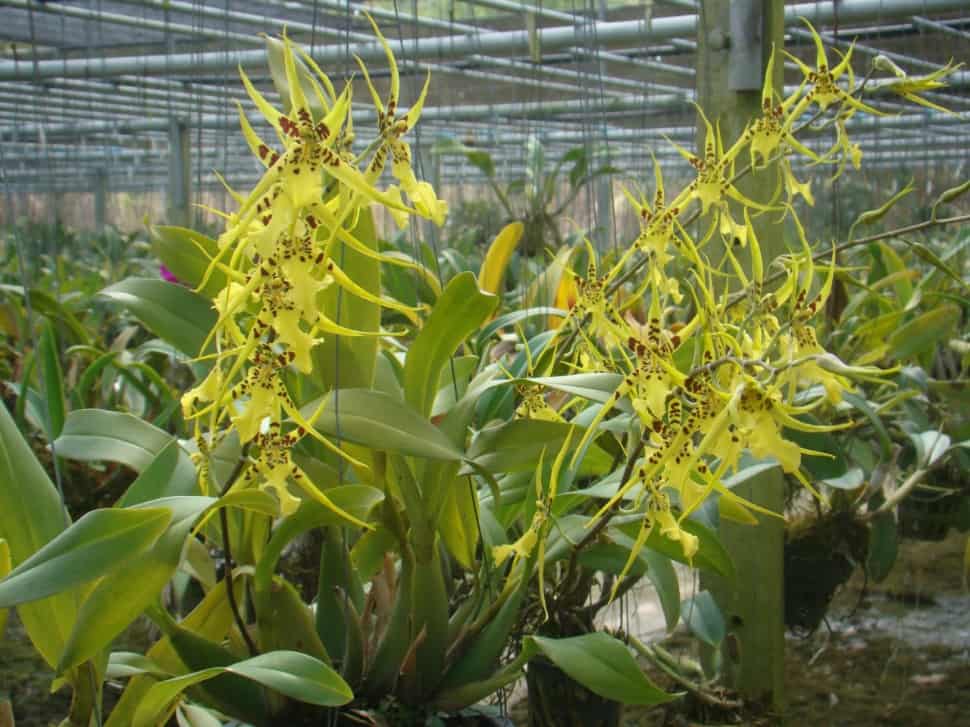

Lighting
Brassia orchid prefers bright, but diffused light. It is advisable to place the flower pot near the western or eastern windows. If you are growing a tropical beauty on a southern windowsill, be sure to darken it at noon. To do this, hang tulle or gauze over the pot.
If the apartment has free space only near the northern window, then be sure to arrange the orchid with additional lighting with a phytolamp. And keep in mind that daylight hours for culture should last 10 hours.
In winter, the plant often suffers from a lack of light, even on the southern and eastern windowsill. Therefore, it is advisable to highlight the culture on cloudy days with a phytolamp.
